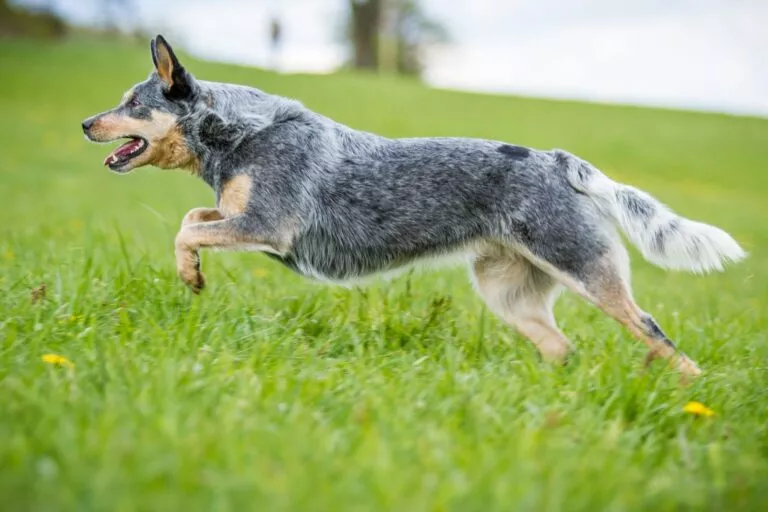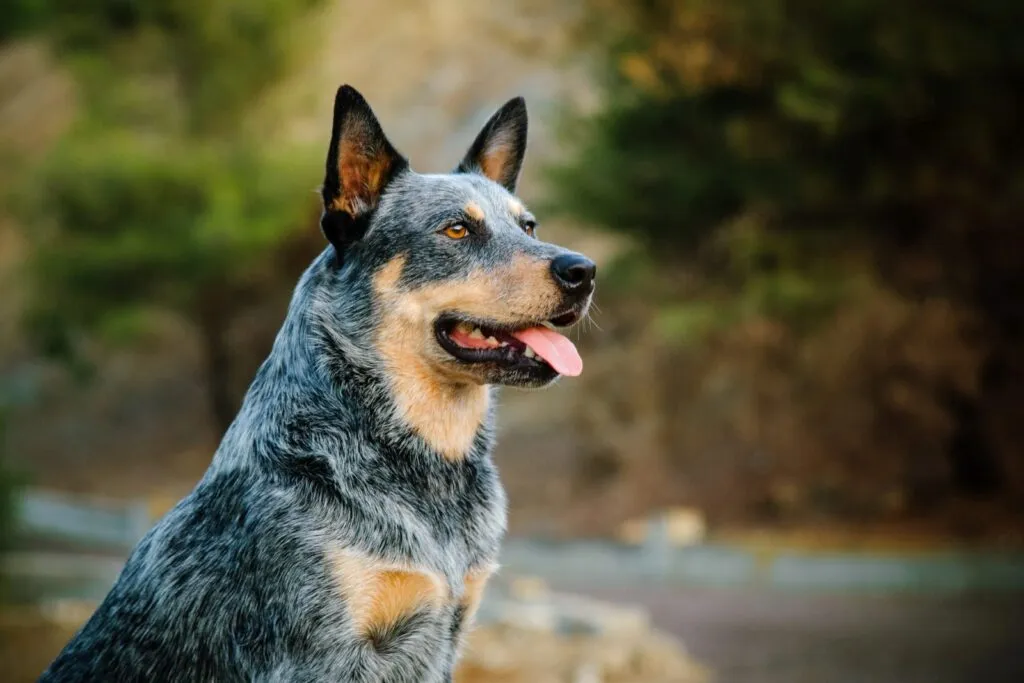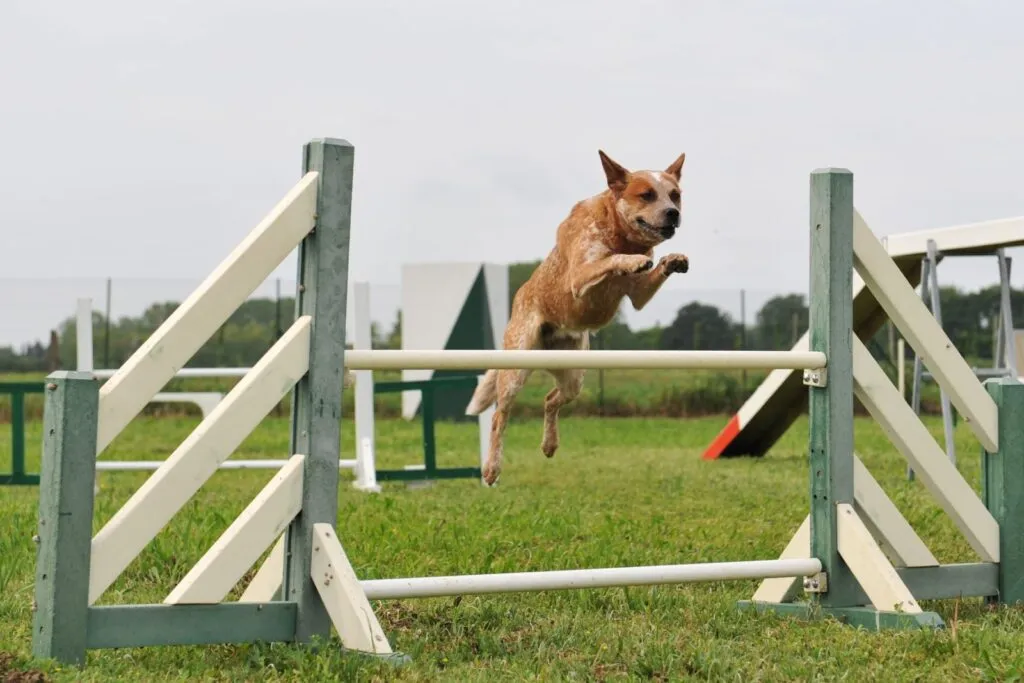Medium Size Poodle
The Australian Cattle Dog has fans across many continents. It's no surprise, really—the Australian Heeler, as it is also known, is not only a colourful sight. This breed brings athleticism, loyalty, and a unique character.

© hemlep / stock.adobe.com
The athletic Australian Cattle Dog sports a dense coat in blue or red speckled patterns—puppies are born white and develop color as they grow
The medium-sized Australian Cattle Dog is a powerful working dog with a sporty, compact frame. Its erect ears sit on a broad skull, and its undercoat is dense.
According to breed standards, the desired coat colours are as follows: Blue (blue), blue speckle (blue speckle), blue mottle (blue mottle), and red speckle (red speckle).
Among other, less desired colours, there is also red (even red) with minimal white speckles and red motled dogs. Do note that puppies are born white and get their speckles as they grow.
Males are generally larger than females. Adult males reach a height at the withers of 46 to 51cm, while females are between 43 and 48cm. Adult males weigh 15 to 24kg, with females weighing 14 to 18kg.
Courage and endurance enable the Australian Heeler to excel as a herding dog. However, this sturdy powerhouse also makes an excellent companion dog. It is not only intelligent and hardworking but also loyal to its pack.
Towards strangers, the herding dog is rather reserved, making it a great watchdog. Male dogs may sometimes show intolerance towards other dogs.
The sport dog also has its quirks—essentially, a genuine character. As a herding dog, it’s used to working independently and tends to assert its will.
Hierarchy and a firm place within it are very important to the Australian Cattle Dog. It will gladly submit to a worthy pack leader, showcasing loyalty and a great character in return, often bonding strongly with one family member.
The Australian Cattle Dog senses uncertainty and can quickly take advantage of it. Therefore, alongside consistent behaviour, a confident demeanour is crucial for owners of this breed.
Always remain calm and confident when working with your Australian Heeler. Consistency, not harshness, is the key to success—otherwise, your free-spirited canine will block you out.
To ensure your pet doesn’t become easily distressed, start training it from a young age. Join puppy play sessions and dog training classes. There, your young lone wolf can meet various breeds and enhance its social skills.
 © Stefan Mager / stock.adobe.com
© Stefan Mager / stock.adobe.com
This agile breed does not belong in a small city flat. It needs space to play, long walks in nature, and ideally a large yard to watch over and herd.
Family connection is also crucial, as this dog forms strong bonds with its reference people. Dog lovers opting for an Australian Cattle Dog should have suitable space and plenty of time daily for their new family member.
Daily walks and the training of this energetic dog are necessary for many years. Only those who dedicate their heart and soul to its care and training will enjoy many years with this active herding dog.
If all criteria are met, even responsible and eager beginners can manage this breed.
The Australian Cattle Dog thrives on physical activity. Luckily, there are many ways you can engage together:
Adult dogs are excellent companions for riding or cycling tours. Their minimal prey drive but high follower instinct makes them ideal for such excursions.
Whether it’s agility or dog dancing, these dogs enjoy dog sports. Experiment to find what suits you both. Remember to train appropriately for its age.
Thanks to their intelligence, they can be trained as therapy or rescue dogs. And, of course, they remain outstanding herding and driving dogs, tasked with their original duties on large properties.
The coat care of an Australian Heeler is straightforward. Brush the fur one to two times a week to remove loose hairs. During shedding periods, groom your dog more frequently.
If your dog is dirty, usually letting the dirt dry and brushing it out suffices. Bathing is rarely necessary and should be done with a mild dog shampoo.
Regularly check the eyes and ears, which you can clean with special solutions if needed.
Keep an eye on the claws. If they are not worn down sufficiently, especially in older dogs, trim them with claw scissors. If unsure, your vet can show you how to trim them.
 © everydoghasastory / stock.adobe.com
© everydoghasastory / stock.adobe.com
An appropriate diet rich in high-quality proteins and nutrients benefits your dog.
How much to feed depends on its age and weight. The manufacturer’s information on the daily food amount serves as guidelines, which you should adjust based on your dog’s condition and activity level.
Australian Cattle Dogs can sometimes overeat. Overweight is detrimental to your dog’s health, so maintaining a slim profile is important. If your dog gains weight, consider adjusting its daily ration.
Treats, though tasty, should be cut out if your dog is overweight and replaced with dry food from its measured daily ration.
Ensure fresh water is always available in sufficient quantities for your dog.
Certain Australian Heeler lines are predisposed to particular hereditary diseases. A reputable breeder is your best protection against hereditary issues.
The breed’s eyes can suffer from various defects, such as generalised progressive retinal atrophy (gPRA) or lens luxation (PLL).
Without treatment, these eye diseases can lead to cataracts and eventual blindness. Genetic tests can screen for some of these defects.
Congenital deafness is also a significant problem and can be unilateral or bilateral. Purchase only from breeders who conduct audiometric hearing tests.
Tip: Large facial masks and dark body markings reduce the risk of deafness.
The breed is also prone to spinal conditions such as spondylosis (spine wear) and diffuse idiopathic skeletal hyperostosis (DISH).
For spondylosis, hereditary factors are not always present, but responsible breeders should provide X-rays of the parent dogs. Similarly, breeders should test the parents’ hips for hip dysplasia.
A healthy Australian Cattle Dog is very robust and can live up to 14 years or more.
 © cynoclub / stock.adobe.com
© cynoclub / stock.adobe.com
The Australian Cattle Dog has a diverse ancestry. European immigrants’ dogs in Australia contributed to the breed.
These dogs helped farmers drive large cattle herds over vast distances. Early dogs resembled the ancestors of today’s Bobtails, but long coats were disadvantageous in Australia’s climate.
Thomas Simpson Hall (1808-1870) was a pioneer in breeding Australian Cattle Dogs. In the early 19th century, he imported hornless cattle from Great Britain and started a dog breeding programme. He crossed spotted working dogs (Drover Dogs) with tamed Dingoes.
The resulting “Hall’s Heelers” were efficient work dogs. After Hall’s death, breeders mixed these dogs with other breeds, including Australian Kelpies, to achieve a more harmonious appearance.
This led to the development of modern Australian Cattle Dogs, and the first breed standard was published in 1903. Over time, a distinction between working and show lines emerged.
If you’ve fallen for the Australian Cattle Dog, you have primarily two options to find your dream dog. Either buy a puppy from a breeder or inquire at a nearby animal shelter. Often, purebred dogs wait for new homes there.
Young dogs from reputable breeders have corresponding prices. Most offers start at £2,000, depending on origin.
Additionally, consider the ongoing costs, as dogs continuously incur expenses—especially for food, taxes, insurance, and vet visits.
Here, skimping is not advisable. Buy puppies only from reputable breeders. You can typically find a list of official breeders on the websites of official breed clubs or national breeder associations.
One thing is certain: The Australian Cattle Dog needs guidance and encouragement. If you structure your pet’s everyday life with activity and discipline, you’ll have a loyal companion.
Motivated beginners may find the Australian Cattle Dog suitable under certain conditions. This includes thoroughly understanding the breed’s nature to raise a balanced dog.
| Brief Info: | Australian Cattle Dogs are robust, medium-sized dogs with a strong herding and protective instinct. |
| Height at withers: | 46-51cm (males), 43-48cm (females) |
| Weight: | 15-24kg (males), 14-18kg (females) |
| Average life expectancy: | 14 years |
| Price: | from £2,000 |
| Temperament: | active, hardworking, loyal |
| Coat: | short, dense undercoat |
| Coat colour: | Blue and red, speckled / mottled |
| Training effort: | medium |
| Care effort: | low |
| Exercise requirement: | high |
| Origin: | Australia |
Fans of the Bearded Collie agree that those who aren't familiar with this dog breed simply have to get acquainted with it. And those who have experienced how a Bearded Collie bolts across meadows with its flowing fur, how it rolls around full of energy and joy and how it attentively and observantly takes into account its owners wishes become simply addicted to this original dog breed and its unique charm.
The Goldendoodle isn't a breed, but a pairing between Golden Retrievers and Medium or Standard Poodles. Marketed as a low-maintenance dog for allergy sufferers, this hybrid is enjoying increasing popularity amongst dog lovers, similar to the Labradoodle.